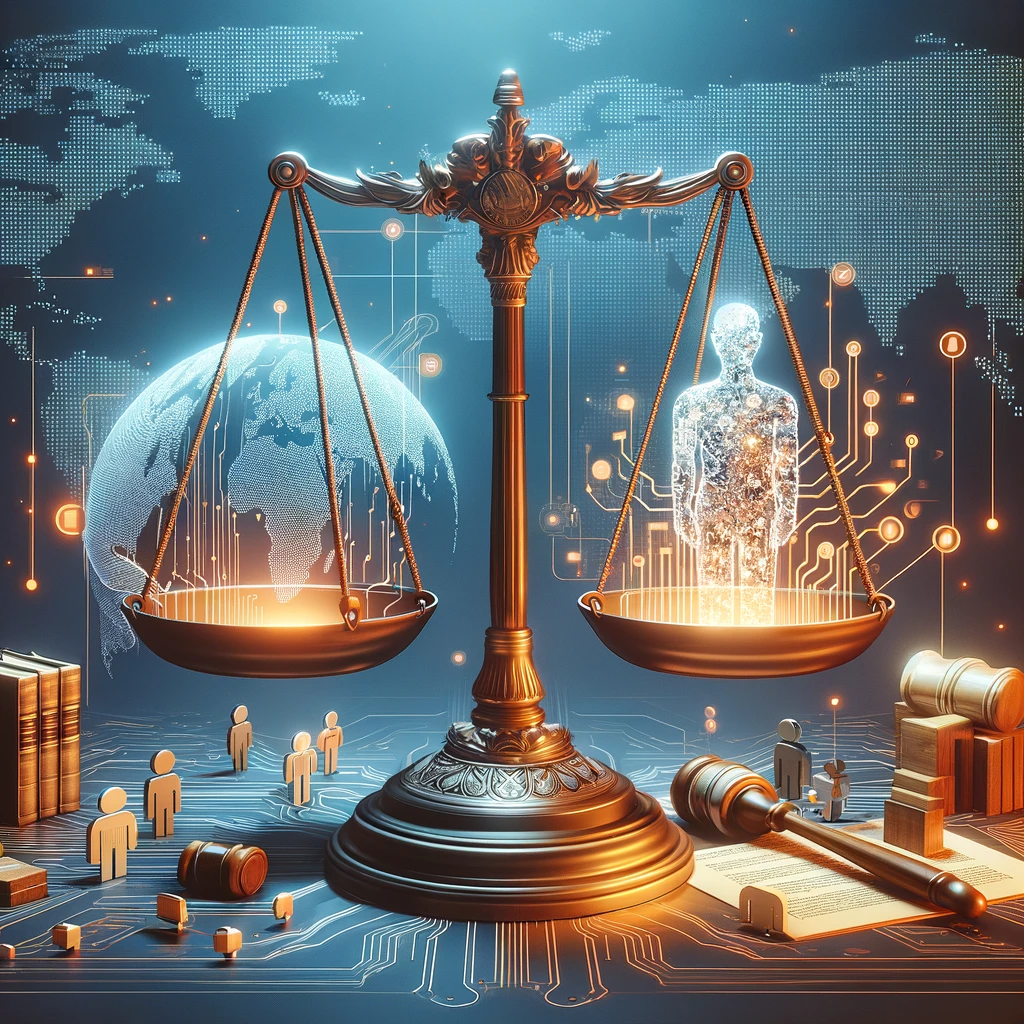The EU AI Act and the Future of Artificial Intelligence

The European Union leads the way in AI regulation, balancing technological advancement with ethical governance.
- What does the EU’s AI Act aim to achieve in the realm of artificial intelligence regulation?
- How does the AI Act categorize AI systems based on risk, and what implications does this have for different types of AI applications?
- What governance mechanisms does the AI Act introduce to ensure compliance and promote ethical AI development across the European Union?
In an unprecedented move, the European Union has pioneered the first global legislation, dedicated to regulating artificial intelligence, the AI Act. Today, March 13, 2024, members of the European Parliament approved the text with 523 votes in favor, 46 against, and 49 abstentions. This landmark regulation aims to harness the vast potential of AI technologies while ensuring they operate within a framework that safeguards human rights and democratic values. Here, we delve into the nuances of the AI Act, providing a detailed overview from high-risk concerns to low-risk applications, setting a global precedent for the responsible development and deployment of AI.
A Risk-Based Framework: The Foundation of the AI Act
At the heart of the European Union’s groundbreaking AI Act lies a meticulously structured risk-based framework, a cornerstone designed to navigate the complex terrain of artificial intelligence regulation with precision and foresight. This innovative approach categorizes AI systems based on the level of threat they pose, not just to individual rights but also to societal values and public safety, thereby establishing a regulatory landscape that is both nuanced and robust.
Unacceptable Risks: The AI Act identifies certain uses of artificial intelligence as fundamentally incompatible with core EU values and human rights, thereby categorizing them as bearing ‘unacceptable risks.’ These include AI systems that deploy subliminal techniques to manipulate individuals to a degree that can cause harm, those designed for social scoring by governments, and AI applications that enable ‘real-time’ biometric identification in public spaces. Such uses are met with a strict prohibition, underscoring the EU’s commitment to safeguarding fundamental freedoms and human dignity.
High Risks: AI systems classified under ‘high risks’ are subject to stringent regulatory requirements due to their significant implications for individual and public well-being. This category includes AI technologies used in critical infrastructures, educational or vocational training that can determine access to education and professional course of one’s life, employment, and workers management, essential private and public services, law enforcement, migration management, and administration of justice and democratic processes. These systems must adhere to strict standards regarding transparency, data quality, and accountability before they can be deployed, ensuring that their operation is both ethical and secure.
Limited Risks: For AI systems that pose ‘limited risks,’ the AI Act mandates transparency obligations to inform users when they are interacting with an AI system. This category is particularly relevant for AI-driven chatbots, which necessitate clear disclosure to users, thereby preserving human agency and autonomy by allowing informed decisions about whether to engage with these systems.
Minimal Risks: Lastly, AI applications considered to pose ‘minimal risks’ are largely exempt from regulatory constraints, allowing for maximum innovation and development freedom. This category acknowledges that most AI applications, from video games to spam filters, do not significantly impinge on individual rights or societal values and thus can operate without stringent oversight.
This risk-based framework exemplifies the EU’s pragmatic and balanced approach to AI governance. By differentiating AI applications according to their potential impact, the AI Act aims to harness the benefits of artificial intelligence, driving technological innovation and economic growth, while firmly anchoring the deployment of AI systems in a foundation of trust, ethical standards, and respect for human rights.
The Prohibited Practices: Non-Negotiable Boundaries
The AI Act sets clear boundaries on the usage of artificial intelligence by categorizing certain practices as unequivocally off-limits, aimed at safeguarding the fundamental rights of individuals and maintaining the ethical integrity of AI technologies. Specifically, the legislation prohibits using AI systems for social scoring by governmental bodies, which could lead to discrimination or unfair treatment of individuals based on their behavior or personal characteristics. Additionally, AI applications designed to exploit the vulnerabilities of specific groups, particularly minors or individuals with disabilities, to manipulate or coerce, are strictly forbidden. This includes AI that could push individuals towards harmful behaviors or decisions they would not have otherwise made. Furthermore, the Act bans AI-driven indiscriminate surveillance practices, including the mass collection and analysis of personal data, thereby addressing concerns over privacy and unlawful monitoring of individuals. These prohibitions reflect a commitment to ethical AI development and deployment, ensuring that technologies are used in a manner that respects human rights and societal values.
High-Risk AI Systems: Under the Regulatory Microscope
The AI Act places a special emphasis on AI systems classified as high-risk due to their potential impact on critical sectors such as critical infrastructure, education, employment, law enforcement, and essential public services. To address the unique challenges these systems present, the Act imposes stringent regulatory requirements designed to safeguard public interest and individual rights. For AI systems used in critical infrastructure, the focus is on ensuring operational reliability and resilience against disruptions or manipulations. In the context of education and vocational training, the Act prioritizes fairness and transparency, aiming to prevent bias in student evaluations or admissions processes. Employment-related AI systems, including those used for recruitment, worker management, or access to self-employment, are mandated to demonstrate fairness and transparency to prevent workplace discrimination. Law enforcement applications of AI are subjected to particularly rigorous scrutiny, especially in predictive policing or evidentiary evaluation, to prevent biases and ensure the protection of fundamental freedoms.
Moreover, AI systems utilized in the management and operation of critical infrastructure, intended to predict or identify circumstances that could lead to catastrophic events and disruptions, are required to adhere to high standards of accuracy and reliability. The Act mandates that these high-risk systems undergo thorough assessment procedures, including conformity assessments with prescribed technical documentation and standards, to validate their compliance with predefined safety and ethical benchmarks. The overarching aim is to cultivate a framework where AI systems in high-stakes domains not only augment efficiency and innovation but also align with core ethical principles, ensuring their operations are transparent, unbiased, and underpinned by substantial human oversight. This careful regulation of high-risk AI systems is pivotal in building and maintaining public confidence in the expanding role of AI across various sectors of society.
Limited and Minimal Risk AI: Encouraging Innovation within Bounds
In the intricate landscape of AI regulation, the AI Act delineates a nuanced approach towards AI applications classified under limited and minimal risk categories, striking a balance between fostering innovation and ensuring ethical integrity. For AI systems that present limited risk, such as chatbots and certain interactive AI interfaces, the Act mandates clear transparency requirements. These stipulations compel the developers and deployers of such systems to unequivocally inform users of their interactions with an AI, not a human, safeguarding against potential misunderstandings or deceptions. This level of transparency is crucial in maintaining an informed user base, allowing individuals to make conscious decisions about their engagement with AI technologies.
Conversely, AI applications categorized as posing minimal risk, which encapsulate a broad spectrum of AI innovations used in less sensitive contexts, benefit from a significantly relaxed regulatory framework under the AI Act. This category, embracing a vast array of AI-driven tools, from personalized content recommendations to AI-enabled creative software, is largely exempt from the stringent compliance requirements that govern their high-risk counterparts. This regulatory leniency is grounded in a strategic vision to encourage the continued growth and diversification of the AI sector. By minimizing bureaucratic hurdles for low-risk AI applications, the Act aims to spur technological advancement and creativity within the digital ecosystem, all while upholding fundamental values of safety, privacy, and human dignity. It underscores the EU’s commitment to promoting a vibrant and competitive AI industry that aligns with core societal and ethical standards, ensuring that as AI technologies proliferate, they do so in a manner that benefits society at large without compromising on the principles of human oversight and rights protection.
Innovative Governance for an Ethical AI Future
The AI Act marks a significant stride in the governance of artificial intelligence within the European Union, establishing the European AI Board as a cornerstone for cohesive oversight. This pioneering body symbolizes the EU’s commitment to a harmonized approach, ensuring the AI Act’s ambitious standards are uniformly applied across member states. The European AI Board’s mandate extends beyond traditional regulatory oversight; it is tasked with fostering a collaborative environment that not only addresses compliance but also champions innovation within the boundaries of ethical AI use.
Complementing the European AI Board, national supervisory authorities are entrusted with a critical role in the AI Act’s enforcement landscape. Their mission is to ensure that AI systems, especially those with high-risk classifications, adhere to the Act’s stringent safeguards within their respective territories. These authorities are not just gatekeepers but also guides, providing necessary oversight to navigate the evolving challenges of AI technologies. They have the authority to conduct detailed assessments, enforce compliance, and impose corrective measures as needed, acting as the local arms of governance that make the EU’s vision for ethical AI a tangible reality.
A key feature of the AI Act’s governance framework is the promotion of regulatory sandboxes. These environments offer a unique opportunity for developers to test new AI technologies under the watchful eyes of regulatory bodies, fostering innovation while ensuring ethical standards are met. This initiative reflects a profound understanding that the path to ethical AI involves not just strict regulation but also active encouragement of responsible innovation.
By weaving together the strategic oversight of the European AI Board with the operational acumen of national supervisory authorities, the AI Act crafts a comprehensive governance model that stands as a blueprint for the world. It assures that the benefits of AI can be harnessed to their fullest potential while safeguarding the foundational values of human dignity and rights. In this way, the European Union not only leads by example in the realm of AI regulation but also lights the way forward for others to follow in the journey towards ethical and responsible AI development.
Pioneering a Global Standard for AI Regulation
The EU’s AI Act is not merely a regional legislative framework; it represents a visionary step towards establishing a global standard for AI regulation. By meticulously balancing the drive for AI innovation with the imperative to protect fundamental human rights, the EU is charting a course for other nations to follow. As we advance into a future increasingly shaped by AI, the Act provides a blueprint for ensuring that AI enhances human welfare, fostering an era of responsible AI development and utilization across the globe.
In summary, the AI Act’s comprehensive approach, from addressing high-risk applications to fostering low-risk AI innovation, encapsulates the EU’s ambitious vision for a future where technology and ethical governance coalesce. As this pioneering legislation unfolds, it paves the way for a harmonized, ethical AI landscape that other global entities are likely to emulate, shaping the future of AI governance worldwide.
As we venture further into the implications and future directions of the AI Act, it’s clear that this landmark regulation is part of a broader narrative on the global stage of AI governance. For readers interested in delving deeper into the evolution of AI regulation, the influence of Silicon Valley, and the EU’s pioneering role in this space, I encourage you to explore my previous articles. “Navigating the Maze of AI Regulation: The EU’s Landmark Journey and Silicon Valley’s Influence“, “AI Regulation in the EU: Navigating New Frontiers in Technology Governance“, and “Navigating the Future of AI: An Exclusive Interview on the EU’s Landmark Regulation” provide further insights and perspectives on these critical issues. These articles offer a comprehensive look at the challenges, debates, and potential impacts surrounding AI regulation, enriching our understanding of what the AI Act means for the future of technology, society, and global collaboration.




